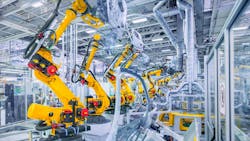Industry 4.0 Gains Are Ahead of the Tools to Measure Them
If Austrian economist Joseph Schumpeter is the father of creative destruction, then today’s entrepreneurs and inventors are his disciples. The term “creative destruction,” coined by Schumpeter in his 1942 book Capitalism, Socialism, and Democracy, refers to the dismantling of traditional business and economic models to make way for revolutionary technologies and innovative processes designed to vastly improve living standards.
We are living in the early stages of one of those historic periods. The Fourth Industrial Revolution, or Industry 4.0, has accelerated us into the digital age of manufacturing while seemingly boosting productivity, efficiency, competitiveness and the prosperity of nations worldwide.
Yet there is often an excruciating lag and prolonged learning curve between a new way of producing things—which initially displaces labor from the old economy—and developing a workforce with the skills required for the modern one. This is particularly true when workers lack a formal education or a skilled trade that would enable them to transfer their talent to the new economy.
Another obstacle is the prolonged reorientation of capital and other resources from one segment of the economy to the new kids on the block. Simply put, introducing modern technologies does not instantaneously diminish the pain of job losses or suddenly reap dividends when upstarts replace the incumbents.
This is why the benefits of technological innovation (advanced semiconductors and computer hardware) are difficult to gauge right away. In 1987, MIT Nobel Prize economist Robert Solow famously said, “You can see the computer age everywhere but in the productivity statistics.” Why is that? Solow alluded to the “productivity paradox,” where the anticipated economic gains from technology were being not fully realized.
Delayed Adoption and Acceptance
When Apple, Microsoft and Dell Computer burst onto the scene in the 1970-80s, computer usage was limited to early adopters or those who could afford a personal computer. The technology did not receive widespread consumer acceptance until the 1990s when prices came down and quality improved. When this lull in consumer acceptance was overcome, an enormous productivity boom followed.
Historically, we have witnessed the slow adoption, integration and growing pains of other general-purpose technologies such as steam, mechanization and electricity. Despite James Watts patenting the steam engine in 1769, the first significant commercial railway did not debut until 1830. Similarly, it took five decades between Thomas Edison patenting the electric lightbulb (1879) to when they became widely used by U.S. households in the 1930s. The electrical grid and its supporting infrastructure to light up homes was not widely available until then. Like past economic transitions, today’s digital wave and its industry laggards are struggling to catch up, boost their technological knowledge, and overcome similar barriers to adoption. Once they do, productivity will rise sharply as workers shift from lower-value to higher-value activities.
GDP: An Outdated Tool
Another explanation for the productivity paradox is that the Gross Domestic Product (GDP) is an outdated relic from the 1930s that fails to capture the intangible services of our economy that now account for 70% of total U.S. GDP. The GDP may be a proxy of success when reporting absolute income and wealth nationwide but neglects the aggregate nuances of income inequality, wage disparity, and sustainability.
Even the creator of the GDP, Simon Kuznets, argued that it was a poor barometer of well-being. Keep in mind that GDP is a measure of a manufacturing age of more than 90 years ago that accounted for physical products only as opposed to intangible services emblematic of today’s most technologically innovative and highly developed economies.
Drilling down to manufacturing productivity, GDP and other contemporary econometric models fail to capture the value-added aspects of innovative technologies and processes increasing worker output. Among other things, they exclude the impact of AI and machine learning, automation and robotics, IT integration, e-commerce, improved processes and workflows and scaled-up supply chains. Therefore, the shift from traditional to digital manufacturing is not readily apparent.
For example, many U.S. companies have outsourced their internal computer systems and IT to cloud computers located overseas. By shifting these tasks and IT infrastructural investments overseas, a U.S. company’s economic domestic output is reduced based on the GDP – even though doing this makes companies more efficient.
Another anachronistic shortfall of GDP is not factoring into the equation today’s software-first approach to manufacturing products that inextricably intertwines physical hardware with software (e.g., embedded sensors). This makes it difficult to discern where the hardware ends and the software begins (and vice versa). The physical boundaries that existed between the physical and cyber worlds have become blurred.
Again, current economic metrics are woefully inadequate at capturing the significant contributions Industry 4.0 and the advent of digitalization have made to the lifeblood of industrial value chains and consumer welfare. The rapid rise in raw computational power that enables this phenomenon is perhaps best illustrated by the rapidly rising software and increased functionality in new cars and trucks, which now exceeds more than 100 million lines of computer code.
GDP also neglects to bake in the value of inexpensive and free online services such as Google’s search engine, ChatGPT, LinkedIn, streaming television and financial software. It also leaves out improvements in the quality of consumer goods, their longevity, and less expensive costs in real dollars. Most glaringly, it does not account for other important sectors of the economy such as healthcare (17.3%), education and finance. This lack of meaningful data considerably underestimates total national output and information technology’s impact on business processes, productivity, quality, sustainability and human welfare.
Another statistical artifact that distorts economic strength is the Gini coefficient designed to gauge income distribution and inequality among huge swaths of the population. Like the GDP, it fails to capture the digital dark matter underlying important sectors of the global economy.
Substitutes for or complements to the GDP aimed at enhancing our understanding of human progress and well-being (e.g., the Organization of Economic Co-operation Development’s Better Life Index or the UN’s enlightened National Happiness Report) are also unable to capture the complexity of the world economy or the exponential pace of digital technology and scientific discovery.
More Refined Metrics = Better Investment Knowledge
Developing statistics, algorithms and standards that can make realistic sense of the New Economy’s performance is a Nobel-worthy pursuit given how critical data is for academia, government policymakers, and business and industry leaders. More precision is particularly important for private and public sector decision-makers to direct future research and development spending to industrial and technological sectors that have the greatest impact in boosting efficiency, productivity and the wealth of nations.
More refined metrics of output will offer manufacturers unprecedented knowledge on where to allocate future capital investments to optimize output and generate more promising returns.
Economists and statisticians will also need to take a more cross-disciplinary approach to cultivating metrics that measure what cannot be measured today—including artificial intelligence and machine learning. They, like the general-purpose technologies noted above, serve as force multipliers rippling through the entire economy.
About the Author

Noel H. Nevshehir
Automation Alley
Noel Nevshehir is director of Automation Alley’s International Business Services and Global Strategic Partnerships. In this role, Nevshehir is responsible for leading Automation Alley’s trade mission program and foreign direct investment efforts. He is also responsible for seeking out global strategic partners that align with Automation Alley’s Industry 4.0 mission.
